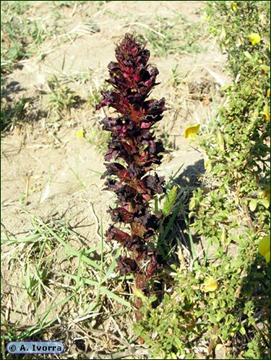CGKB News and events stog-chickpea
Viruses - chickpea
Contributors to this page: ICRISAT, India (RP Thakur, AG Girish, VP Rao); ICARDA, Syria (Siham Asaad, Abdulrahman Moukahal).
|
Contents: |
Scientific Name
Pea Seedborne Mosaic Virus (PSbMV).
Other scientific names
Pea fizzle top virus, pea leaf rolling virus, pea leaf roll mosaic virus, pea leaf rolling mosaic virus.
Significance
PSbMV is of economic importance in pea, faba bean and lathyrus, mainly due to its effect on seed quality. It has been mistakenly considered to be a minor disease because it often causes only minor yield loss and mild symptoms. However, at the International Centre for Agriculture in the Dry Areas (ICARDA), Syria, glasshouse studies on yield losses due to PSbMV in chickpea, faba bean, lentil and pea showed losses of 66%, 40.5%, 44.6% and 49.2% respectively. Surveys of pulse crops over a number of years showed that up to 15% of crops were infected with PSbMV, with a within crop incidence of up to 5% of plants. In surveys in WA in 1999, PSbMV was found in 42% of field pea crops and the level of virus detected in pea seed stocks was up to 63%. The surveys in WA indicated that PSbMV has a severe effect on seed quality of pulse crops with seed coat symptoms evident on >80% of faba bean, >50% of lathyrus species and field peas and 5% of chickpea seed.
Symptoms
The disease is characterized by a mild mottling on the leaves.
The affected plants are reduced in growth, which is easily recognized, especially when they are compared with healthy plants. Yield reductions of 15-16% could occur in some different cultivars. Seeds from infected plants occasionally show dark staining on the seed.
Plants may show no symptoms or there may be chlorosis in new shoots, mottling on leaves, shoot tip necrosis and stunting of plants.
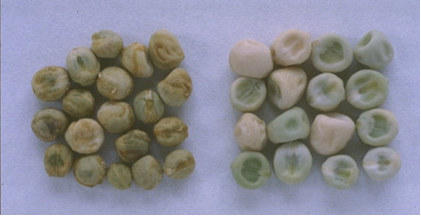 PSbMV (photo: www1.agric.gov.ab.ca) |
Hosts
The natural host range of PSbMV is limited to the Fabaceae. It infects temperate pulses (chickpea, faba bean, field pea, lentil) other legumes (garden pea, narbon bean) and pastures (lathyrus and vetch). A number of PSbMV pathotypes have been recognised by their ability to infect a number of pea differential genotypes.
Geographic distribution
Cosmopolitan.
Biology and transmission
The virus is believed to have spread worldwide through the exchange of infected seed. Seed transmission rates of up to 100% in peas and up to 44% in lentils have been reported. In Victoria, we have detected PSbMV at low levels in some commercial chickpea seedlots (0.4% of seed) and at higher levels in field pea and lentil seedlots (greater than 2% of seed). In the USA, 3% PSbMV infection in pea seedlots and 32-40% in lentil seedlots have been reported. At ICARDA, PSbMV was found to be transmitted through lentil seeds at rates of up to 44%. PSbMV is also transmitted in a non-persistent manner by more than 20 aphid species and by mechanical means. The most efficient vector is the pea aphid (Acyrthosiphon pisum). The other species are as follows: A. pelargoni, A. sesbaniae, Aphis craccivora, A. fabae, A. gossypii, A. nasturtii, Aulacorthum circumflexum, A. solani, Brevicoryne brassicae, Cryptomyzus ribis, Dactynotus escalantii, Macrosiphum avenae, M. euphorbiae, M. pisi, M. rosae, Metopolophium dirhodum, Myzus persicae, Ovatus crataegarius, Phorodon cannabis, Rhopalosiphum padi and Semiaphis dauci. In Victorian pulse crop surveys, we have found cowpea aphid (Aphis craccivora), foxglove aphid (Aulacorthum solani) and green peach aphid (Myzus persicae), which are all vectors of PSbMV.
Detection/indexing method in place at the CGIAR Centres
- At ICARDA - Not important. TBIA, Enzyme-linked immunosorbent assay (ELISA), Tissue blot immunoassay (TBIA).
- At ICRISAT - Not applicable.
Treatment
- Seed is considered to be the main source of PSbMV, therefore sowing virus tested seed is the most effective way of controlling this virus. Commercial seed tests are available.
- Chemical control of aphids is not an effective method for controlling non-persistently transmitted viruses, such as PSbMV. Pulse crops should be sown away from other legumes to minimize the spread of PSbMV.
References and further reading
http://www.icarda.org/Publications/Field_Guides/Lentil/Lent7.Html
http://image.fs.uidaho.edu/vide/descr575.htm
http://www1.agric.gov.ab.ca/$department/deptdocs.nsf/all/prm7819
http://www.inra.fr/hyp3/pathogene/6psbmov.htm
Scientific Name
Alfalfa Mosaic Virus (AMV).
Other scientific names
Lucerne Mosaic Virus, Potato Calico Virus.
Significance
The studies showed that up to 17% of crops were infected with AMV, with a within-crop incidence of up to 21% of plants.
Symptoms
Chlorosis of the terminal bud and twisting, followed by necrosis and the subsequent proliferation of secondary branches. Such new secondary branches are stiff and erect with smaller leaflets that show a mild mottle.
Very few pods are produced.
Terminal bud necrosis can also be caused by iron deficiency but proliferation of branches is not seen in iron deficient plants.
Hosts
The host range of AMV is wide and not limited to Fabaceae. Temperate pulse hosts include chickpeas, faba beans, field peas, lentils, narbon beans, grass peas and vetch. Pasture legume hosts include lucerne, burr medic and other annual medics and a number of clover species.
Geographic distribution
Algeria, India, Iran, Morocco, New Zealand and USA.
Biology and transmission
The virus is transmitted by a vector; transmitted by mechanical inoculation; transmitted by grafting; not transmitted by contact between hosts; transmitted by seeds (50% in alfalfa seeds from individual infected plants and up to 10% in commercial seed, transmitted by pollen to the seed).
Vector Transmission
The virus is transmitted by arthropods, by insects of the order Hemiptera, family Aphididae; Myzus persicae and at least 13 other species. The virus is transmitted in a non-persistent manner.
Detection/indexing method in place at the CGIAR Centres
- At ICARDA- Not important. Enzyme-linked immunosorbent assay (ELISA), Tissue blot immunoassay (TBIA).
- At ICRISAT- Not applicable.
Treatment
- Chemical control of aphids is not an effective method for controlling AMV.
- Sowing healthy seed, managing weeds and other cultural practices to minimize AMV spread are recommended.
- Growing crops adjacent to infected lucerne or pasture will increase the risk of crop infection.
Procedure followed at the CGIAR Centres in case of positive test
No specific procedures notified.
References and further reading
http://www.icrisat.org/vasat/learning_resources/chickpea/chickpea_diseases/viral_mosaic.htm
http://www.ncbi.nlm.nih.gov/ICTVdb/ICTVdB/00.010.0.01.001.htm
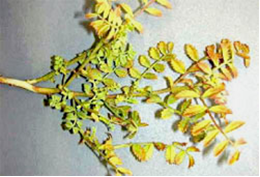 |
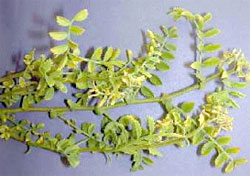 |
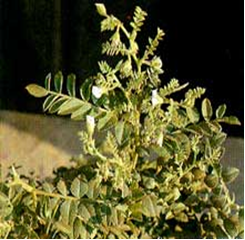 |
|
AMV (photos: www.dpi.vic.gov.au) |
||
Bean Yellow Mosaic, Narrow leaf
Scientific Name
Bean Yellow Mosaic Virus (BYMV).
Other scientific names
Bean Virus 2, Canna Mosaic Virus.
Significance
BYMV is sometimes found in faba bean crops and occasionally in peas with within crop virus incidences of 1-15% and up to 7% respectively.
Symptoms
Yellowing and drying of the plants with feathery and deformed leaves are common.
The leaves below the proliferated branches turn yellow, show interveinal chlorosis, or mosaic depending on the genotype tested. The overall height of the plant is reduced.
Affected plants produce very few, distorted flowers that develop into very small pods.
The seeds from infected plants are black, small, and shriveled.
 BYMV (photo: www.icrisat.org) |
Hosts
The host range of BYMV is wide and not limited to Fabaceae. The virus is reported to infect nearly 200 species in 14 families. Temperate pulse hosts include chickpeas, faba beans, field peas, lentils and lupins. Temperate legume pasture hosts include lathyrus, lucerne, vetch and medic and clover species. BYMV has a number of subtropical and tropical pulse hosts, including soybeans, peanuts and French beans as well as legume pasture hosts. It also infects ornamental hosts, the most common being gladiolus species.
Geographic distribution
The virus is probably distributed worldwide.
Biology and transmission
The virus is transmitted by a vector. The virus is transmitted by mechanical inoculation; and transmitted by seeds up to 3%.
Vector Transmission:
Virus is transmitted by arthropods, by insects of the order Hemiptera, family Aphididae; more than 20 ssp. including Acyrthosiphon pisum, Macrosiphum euphorbiae, Myzus persicae, Aphis fabae. Virus is transmitted in a non-persistent manner.
Detection/indexing method in place at the CGIAR Centres
- At ICARDA - Not important. Enzyme-linked immunosorbent assay (ELISA), Tissue blot immunoassay (TBIA).
- At ICRISAT - Not applicable.
Treatment
- Chemical control of aphids is not an effective method for controlling non-persistently transmitted viruses such as BYMV.
- Pulse crops should be sown away from legume pastures to minimize the spread of BYMV.
- The spread of virus can also be reduced by controlling weed hosts from in and around paddocks.
Procedure in place at the CGIAR Centres in case of positive test
No specific procedures notified.
References and further reading
http://www.icrisat.org/vasat/learning_resources/chickpea/chickpea_diseases/viral_narrowleaf.htm
http://www.ncbi.nlm.nih.gov/ICTVdb/ICTVdB/00.057.0.01.009.htm
Cucumber Mosaic, Proliferation
Scientific Name
Cucumber Mosaic Virus (CMV).
Other Scientific Names
Banana Infectious Chlorosis Virus, Cleus Mosiac Virus.
Significance
In field experiments infection in chickpea was shown to diminish shoot dry weight by 72-81%, seed yield by 80-90% and individual seed yield by 17-25%.
Symptoms
Bushy and stunted plants.
Diseased plants produce few flowers and pods, and many die prematurely.
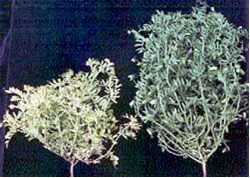 CMV (photo: ICARDA) |
Hosts
Susceptible host species are found in the families: Amaranthaceae, Apocynaceae, Chenopodiaceae, Compositae, Convolvulaceae, Cruciferae, Cucurbitaceae, Leguminosae-Papilionoideae, Malvaceae, Phytolaccaceae, Polygonaceae, Scrophulariaceae, Solanaceae, Tetragoniaceae, Tropaeolaceae, Umbelliferae.
Geographic distribution
The virus is probably distributed worldwide.
Biology and transmission
The virus is transmitted by a vector; the virus is transmitted by mechanical inoculation; it is transmitted by seeds (in 19 species but in variable extents).
Vector Transmission
The virus is transmitted by arthropods, by insects of the order Hemiptera, family Aphididae; more than 60 subspecies including Acyrthosiphon pisum, Aphis craccivora and Myzus persicae. The virus is transmitted in a non-persistent manner.
Detection/indexing method in place at the CGIAR Centres
- At ICARDA - Not important. Enzyme-linked immunosorbent assay (ELISA), Tissue blot immunoassay (TBIA).
- At ICRISAT - Not important.
Treatment
- Chemical control of aphids is not an effective method for controlling CMV.
- Sowing healthy seed, managing weeds and other cultural practices to minimize CMV spread are recommended.
- Growing crops adjacent to infected lucerne or pasture will increase the risk of crop infection.
Procedure followed at the centers in case of positive test
No specific procedures notified.
References and further reading
http://www.icrisat.org/vasat/learning_resources/chickpea/chickpea_diseases/viral_proliferation.htm
http://www.ncbi.nlm.nih.gov/ICTVdb/ICTVdB/00.010.0.04.001.htm
Weeds - chickpea
Contributors to this page: ICRISAT, India (RP Thakur, AG Girish, VP Rao); ICARDA, Syria (Siham Asaad, Abdulrahman Moukahal).
|
Contents: |
Scientific names
Orobanche foetida Pers.
Orobanche crenata Forsk.
Orobanche ramosa L.
Significance
Yield reductions of 30 to 70% are not uncommon. International markets may reject broomrape-contaminated produce.
Symptoms
The appearance of the parasite itself is the clearest sign of infestation. The parasite has erect, branched or unbranched aerial flowering shoots. The leaves are reduced to scales and are disposed alternatively. The shoots bear bisexual tubular flowers in a spike. The tiny seeds are produced in enormous numbers in capsules.
Hosts
Broomrapes usually only parasitic to broadleaved plants but there are a few records of attacks on monocots (grasses, etc.). Branched Broomrape attacks many crops and common weeds. Non-host crops can support infestations because of their weed component, and the produce of such crops may carry Broomrape seeds. Some Broomrape species have specialized biotypes or races. Plants of the same species attack different sets of hosts in different geographic areas. Susceptibility to attack also depends on the cultivar or genetic characteristics of a particular crop. The plants attacked by Branched Broomrape around the world include:
Crops: bean, broad bean, cabbage, capsicum (peppers), canola, carrot, cauliflower, celery, chickpea, clovers, eggplant (aubergine), flax, hemp (cannabis), hops, lentil, medicagos, onion, parsnip, paprika, pea, pyrethrum, sunflower, tobacco, tomato and potato.
Geographic distribution
Western and Central Asia (especially in Afghanistan, Syria, Egypt, India, Iran, Jordan, Lebanon, Morocco, Pakistan, Saudi Arabia, Australia, Europe (especially the Mediterranean), N. africa and N. america.
Biology and transmission
Seeds germinate in moist soil at 18 to 23°C and require moist soil for one week to become established. The roots parasite the roots of host plants for 40 to 50 days. Stems emerge in spring and are visible for only about three weeks from the end of September through to October. Flowering is rapid, within 6 to 9 days after stem emergence, with a similar period between the cessation of flowering and the ripening of fruit. An infestation may contain many plants that do not produce above-ground parts.
Dispersal from property to property and within properties in the infested area in South Australia appears to be mainly by carriage on vehicles and machinery. Seeds stick to equipment and animals that contact the plant and can also be dispersed by wind and water (including irrigation water/sprinklers), in animal manure, soil, fodder, on livestock and on footwear and clothing. Seeds attach to crop seeds and other produce. Seedlings imported from infested areas can carry seeds stuck to their leaves or in the soil. Seeds remain viable after passage through the digestive tracts of animals including cattle and goats.
Detection/indexing method in place at the CGIAR Centres
- At ICARDA - Filter Wash Test.
- At ICRISAT - Not applicable.
Treatment/control
Hand weed shoots prior to their seed formation to reduce inoculum levels. This is recommended in minor infestations only.
- Sow the crop late to help plants escape the worst effects of infection.
- Plow deep to bury Orobanche seeds into deeper soil layers to reduce infestation.
- Use selective herbicides such as imazaquin (10-15 ml a.i./ha).
- Use soil solarization to reduce soil-borne inoculum.
- Use resistant varieties, if available.
Procedure followed at the CGIAR Centres in case of positive test
- At ICARDA - Mechanical rotation, herbicides.
- At ICRISAT - Not applicable.
References and further reading
http://www.agroatlas.ru/en/content/weeds/Orobanche_ramosa/
|
Orobanche foetida (photo: ICARDA) |
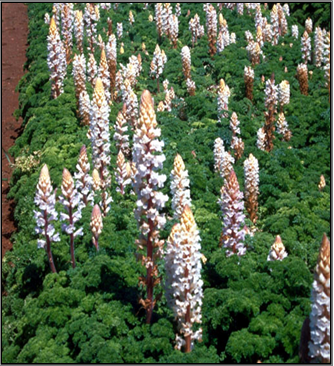
Orobanche crenata (photo: ICARDA) |

Orobanche ramosa (photo: ICARDA) |
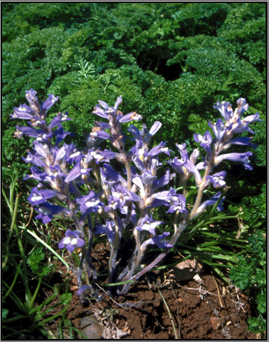
Orobanche egyptiaca (photo: ICARDA) |
Scientific name
Cuscuta hyalina Roth.
Other scienfiic name
Cuscuta pentagona.
Significance
The effect of field dodder on 12 legume crops was investigated in a greenhouse experiment. The legume crops showed great variations in response to field dodder parasitism. Based on the reduction in host dry weight (biological yield) caused by the parasite, chickpea lost >50% of its biological yield and was considered highly susceptible.
Symptoms
The appearance of the parasite itself is the best diagnostic symptom. It has fine, yellow or orange, thread-like branches which grow and entwine around the stems and other aboveground parts of the host.
Dodder-infected areas appear as patches in the field and continue to enlarge during the growing season. In late spring and early summer, dodder produces a massed cluster of white flowers.
Infected host plants become weakened, decline in vigour and produce poor yields.
Several patches might coalesce to form large areas that can be easily recognized by the yellowish colour of the parasite strands.
Hosts
Cuscuta species attack a wide range of species including vegetables, fruits, ornamentals and woody plants. It is reported as a weed in 25 crops in 55 countries.
Geographic Distribution
Cosmopolitan.
Detection/indexing method in place at the CGIAR Centres
- At ICARDA - Filter Wash Test.
- At ICRISAT - Not applicable.
Treatment/control
- Cultural Practices: Dodder is best controlled through prevention by using clean seed. Ornamental beds should be kept clean of seed-producing plants. Once dodder becomes established, eradication is almost impossible. Mechanical removal can be attempted, but once dodder has produced the haustoria it is almost impossible to avoid damage to the host plant. If dodder has germinated and has attached to a host plant, removal of both is recommended to eradicate.
- Herbicide Use: use of pre-emergent herbicides is the best chemical approach. These products must be applied prior to the germination of the seed as the small seedling root will drop off once the haustoria has formed. Dinitroanaline herbicides have been reported to be effective. Dichlobenil has also shown good results. Read all labels to ensure that the herbicides can be used around the host plants. Glyphosate has shown results as a postemergent herbicide, but its use is limited as it will also damage the host plant. Phenoxy herbicides have only shown limited control and again, injury to the host plant can occur.
Procedure followed at the CGIAR Centres in case of positive test
- At ICARDA - Mechanical control, cultural practices and herbicides.
- At ICRISAT - Not applicable.
References and further reading
http://www.icarda.org/Publications/Field_Guides/Lentil/Lentil.htm#Lent7.Html
http://www.weedalert.com/weed_pages/wa_dodder.htm
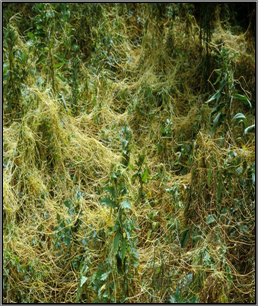
Cuscuta hyalina (photo: ICARDA) |
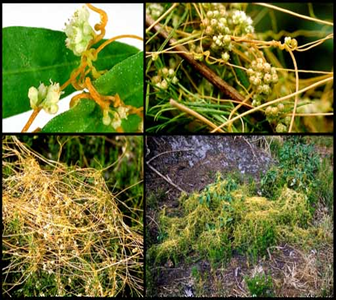
Cuscuta campestris (photo: ICARDA) |



 stog-chickpea
stog-chickpea

